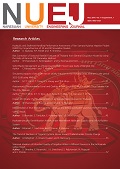Simulating impacts of sea level rise on salinity intrusion in the Mekong Delta, Vietnam in the period 2015-2100 using MIKE 11
Main Article Content
Abstract
The Mekong Delta was studied to quantify the impact of sea level rise on the salinity intrusion in the period 2015-2100. Sea level rise (RCP 4.5 and RCP 8.5) scenarios suggested that the sea level increases by 0.07 to 0.48 m in the future (2030s, 2050s, and 2080s). The MIKE 11 model (Hydrodynamic module and Advection-Dispersion module) was used to investigate the impact of saltwater intrusion under sea level rise scenarios. The model was calibrated and validated using observed data. The calibration and validation results indicated that the MIKE 11 model was able to simulate the streamflow and salinity concentration, with NSE values exceeding 0.53 for both calibration and validation periods. Their differences in simulating the salinity concentration under sea level rise scenarios were also analyzed. The results indicate salinity concentration increases by 1.2% to 10% in the future. This means that the saltwater will move deeply inland in the future and have significant impacts on agricultural activities and livelihoods of farmers in the Mekong Delta.
Article Details

This work is licensed under a Creative Commons Attribution-NonCommercial-NoDerivatives 4.0 International License.


